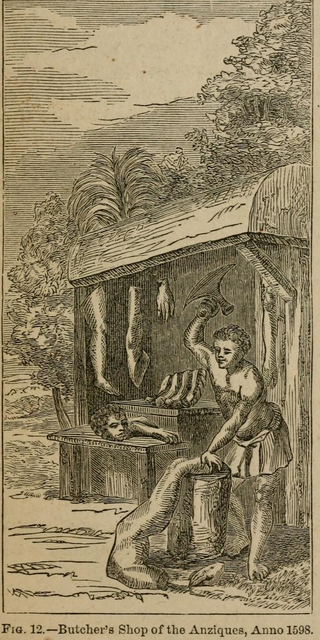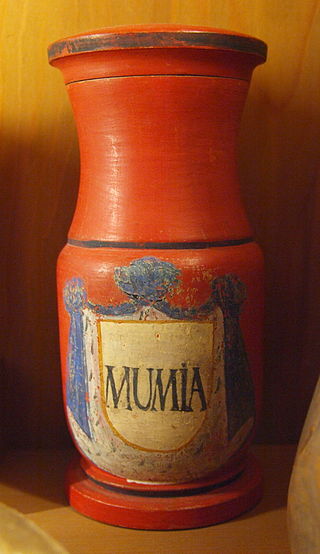Cannibalism is the act of one individual of a species consuming all or part of another individual of the same species as food.
Contents
Cannibalism may also refer to:
Cannibalism is the act of one individual of a species consuming all or part of another individual of the same species as food.
Cannibalism may also refer to:

Human cannibalism is the act or practice of humans eating the flesh or internal organs of other human beings. A person who practices cannibalism is called a cannibal. The meaning of "cannibalism" has been extended into zoology to describe animals consuming parts of individuals of the same species as food.
Cannibalization or cannibalisation may refer to:
Wendigo is a mythological creature or evil spirit originating from Algonquian folklore. The concept of the wendigo has been widely used in literature and other works of art, such as social commentary and horror fiction.
Anthropophagy is the custom and practice of eating the flesh or internal organs of human beings. It may refer to:

Alexander "Sawney" Bean is a legendary figure, said to be have been the head of a 45-member clan in Scotland in the 16th century that murdered and cannibalised over 1,000 people in 25 years. According to the legend, Bean and his clan members were eventually caught by a search party sent by King James VI, and were executed for their heinous crimes.
Self-cannibalism is the practice of eating parts of one's own body, also called autocannibalism or autosarcophagy. Generally, only the consumption of flesh by an individual of the same species is considered cannibalism. In line with this usage, self-cannibalism means the consumption of flesh from one's own body. While some texts use this strict definition, others use the term autocannibalism in a wider sense that includes the consumption of hair or nails from one's own body.

Child cannibalism or fetal cannibalism is the act of eating a child or fetus. Children who are eaten or at risk of being eaten are a recurrent topic in myths, legends, and folktales from many parts of the world. False accusations of the murder and consumption of children were made repeatedly against minorities and groups considered suspicious, especially against Jews as part of blood libel accusations.
Cannibalism, the act of eating human flesh, is a recurring theme in popular culture, especially within the horror genre, and has been featured in a range of media that includes film, television, literature, music and video games. Cannibalism has been featured in various forms of media as far back as Greek mythology. The frequency of this theme has led to cannibal films becoming a notable subgenre of horror films. The subject has been portrayed in various different ways and is occasionally normalized. The act may also be used in media as a means of survival, an accidental misfortune, or an accompaniment to murder. Examples of prominent artists who have worked with the topic of cannibalism include William Shakespeare, Voltaire, Bret Easton Ellis, and Herschell Gordon Lewis.

Cannibalism is the act of consuming another individual of the same species as food. Cannibalism is a common ecological interaction in the animal kingdom and has been recorded in more than 1,500 species. Human cannibalism is well documented, both in ancient and in recent times.

Exocannibalism, as opposed to endocannibalism, is the consumption of flesh from humans that do not belong to one's close social group—for example, eating one's enemies. It has been interpreted as an attempt to acquire desired qualities of the victim and as "ultimate form of humiliation and domination" of a vanquished enemy in warfare. Such practices have been documented in various cultures, including the Aztecs in Mexico and the Caribs and Tupinambá in South America.
Armin Meiwes is a German former computer repair technician who received international attention for murdering and eating a voluntary victim in 2001, whom he had found via the Internet.
Filial cannibalism occurs when an adult individual of a species consumes all or part of the young of its own species or immediate offspring. Filial cannibalism occurs in many species ranging from mammals to insects, and is especially prevalent in various types of fish species with males that engage in egg guardianship. The exact evolutionary purpose of the practice in those species is unclear and debated among zoologists, though there is consensus that it may have, or may have had at some point in species' evolutionary history, certain evolutionary and ecological implications.

Acts of cannibalism in Africa have been reported from various parts of the continent, ranging from prehistoric times until the 21st century. The possibly oldest evidence of human cannibalism has been found in Kenya in eastern Africa. There is little evidence of later cannibalism in East Africa, but the Ugandan dictator Idi Amin was reputed to practise it, and acts of voluntary and forced cannibalism have been reported from the South Sudanese Civil War. While the oldest known written mention of cannibalism is from the tomb of the Egyptian king Unas, later evidence from Egypt shows it to only re-appear during occasional episodes of severe famine.

Medical or medicinal cannibalism is the consumption of parts of the human body, dead or alive, to treat or prevent diseases. The medical trade and pharmacological use of human body parts and fluids often arose from the belief that because the human body is able to heal itself, it can also help heal another human body. Much of medical cannibalism applied the principles of sympathetic magic, for example that powdered blood helps bleeding, human fat helps bruising, and powdered skulls help with migraines or dizziness. Medical cannibalism has been documented especially for Europe and China.

Acts of cannibalism in Europe seem to have been relatively prevalent in prehistory, but also occurred repeatedly in later times, often motivated by hunger, hatred, or medical concerns. Both anatomically modern humans and Neanderthals practised cannibalism to some extent in the Pleistocene, and Neanderthals may have been eaten by modern humans as the latter spread into Europe. Amongst humans in prehistoric Europe, archaeologists have uncovered many clear and indisputable sites of cannibalism, as well as numerous other finds of which cannibalism is a plausible interpretation.

Acts of cannibalism in Asia have been reported from various parts of the continent, ranging from ancient times to the 21st century. Human cannibalism is particularly well documented for China and for islands that today belong to Indonesia.

Cannibalism in Oceania is well documented for many parts of this region, with reports ranging from the early modern period to, in a few cases, the 21st century. Some archaeological evidence has also been found. Human cannibalism in Melanesia and Polynesia was primarily associated with war, with victors eating the vanquished, while in Australia it was often a contingency for hardship to avoid starvation.